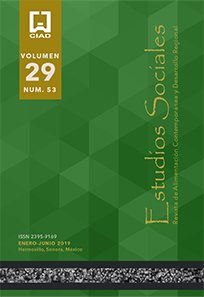Ruta alimentaria en circuitos y producción de traspatio en Donato Guerra, México
Food route in circuits and traspatio production in Donato Guerra, Mexico
Abstract
Objective: Design a food route in circuits considering the backyard livestock activity, its natural and cultural resources in DG for its tourist use. Methodology: Tourist diagnosis that consisted in the application of a questionnaire to 250 visitors through a sampling non-probability, 70 interviews with rural inhabitants, an inventory of their patrimonies was made including an acknowledgment of infrastructure, tourist services; and the observational method for aspects of veterinary medicine and animal husbandry (MVZ) was applied in order to know the management of livestock production units. Results: Backyard production is related to local agricultural resources and traditional recipes derived from their cultural and natural heritage, which is a source of consumption for tourists, empowered through the design of a food route with five circuits, where its inhabitants are willing to incorporate tourism into their activities, and as a way to preserve their environment. Limitations: Agreements between all actors postpone actions. Conclusions: Rural tourism, in the face of the collapse of rural productive areas, can become the channel of distribution and commercialization of the various backyard agricultural products and encourage the use of the attractions of the place. Therefore, it is not about abandoning the agricultural or traditional knowledge, nor the nature of its landscapes, its history, quality of air and water because these are the bases for the community to take advantage of and develop rural tourism.
Keywords:
contemporary food, food route, agricultural backyard production, and cultural and natural tourism resources.Abstract
Objective: Design a food route in circuits considering the backyard livestock activity, its natural and cultural resources in DG for its tourist use. Methodology: Tourist diagnosis that consisted in the application of a questionnaire to 250 visitors through a sampling non-probability, 70 interviews with rural inhabitants, an inventory of their patrimonies was made including an acknowledgment of infrastructure, tourist services; and the observational method for aspects of veterinary medicine and animal husbandry (MVZ) was applied in order to know the management of livestock production units. Results: Backyard production is related to local agricultural resources and traditional recipes derived from their cultural and natural heritage, which is a source of consumption for tourists, empowered through the design of a food route with five circuits, where its inhabitants are willing to incorporate tourism into their activities, and as a way to preserve their environment. Limitations: Agreements between all actors postpone actions. Conclusions: Rural tourism, in the face of the collapse of rural productive areas, can become the channel of distribution and commercialization of the various backyard agricultural products and encourage the use of the attractions of the place. Therefore, it is not about abandoning the agricultural or traditional knowledge, nor the nature of its landscapes, its history, quality of air and water because these are the bases for the community to take advantage of and develop rural tourism.
Keywords:
contemporary food, food route, agricultural backyard production, and cultural and natural tourism resources.Downloads
References
Alderete, J. M. (2004). Trayecto hacia el desarrollo. Rutas alimentarias. Buenos Aires, Argentina: Secretaría de Agricultura, Ganadería, Pesca y Alimentos, Ministerio de Economía. Recuperado de http://www.alimentosargentinos.gob.ar/contenido/revista/ediciones/24/Trayecto_desarrollo.htm
Barrera, E. y Bringas, A. O. (2009). La ruta de la sal prehispánica de Zapotitlán Salinas, una estrategia de desarrollo comunitario basada en los alimentos con identidad local. Tempo-Revista Cultura, Tecnología y Patrimonio, (7), p 33-48, U de G. Recuperado de
http://www.web.valles.udg.mx/investigacion/publicaciones/publicaciones_periodicas
Crespi, M. y Panells, M. (2006). Productos y destinos turísticos nacionales e internacionales. Madrid. España: Síntesis.
Echeverri, R. y Ribero, M. P. (2002). Nueva ruralidad visión del territorio en América Latina y el Caribe. Recuperado de http://repiica.iica.int/DOCS/B0536E/B0536E.PDF
Gobierno del Estado de México (2015). Información para el Plan de Desarrollo Donato Guerra Recuperado de http://187.188.121.162:8090/links/109%20Donato%20Guerra.pdf
Hernández-Sampieri, R., Fernández-Collado, C. y Baptista-Lucio, P. (2014). Metodología de la Investigación 6ª ed. México: McGraw-Hill.
Monterroso, N. y Zizumbo, L. (2009). La reconfiguración neoliberal de los ámbitos rurales a partir del turismo: ¿Avance o retroceso? Convergencia Revista de Ciencias Sociales, 16(50), 133-164. Recuperado de http://www.scielo.org.mx/scielo.php?pid=S1405-14352009000200006&script=sci_abstract
Sedesol (2013). Unidad de Microregiones, Cédulas de Información Municipal (SCIM) Municipios ZAP Rural. Recuperado de http://www.microrregiones.gob.mx/zap/datGenerales.aspx?entra=zap&ent=15&mun=032
Soto, A. F. (2014). Ruta alimentaria en Donato Guerra, La Asunción, una propuesta de turismo rural. (Reporte de aplicación de conocimientos-pregrado). Facultad de Turismo y Gastronomía, Universidad Autónoma del Estado de México. Toluca, México.
Urcelay, V. S. (1989). Epidemiología en las ciencias veterinarias. Monografías de Medicina Veteriana, 11(1) Chile: Facultad de Ciencias Veterinarias y Pecuarias, Universidad de Chile. Recuperado de: https://web.uchile.cl/vignette/monografiasveterinaria/monografiasveterinaria.uchile.cl/CDA/mon_vet_simple/0,1420,SCID%253D17876%2526ISID%253D443%2526PRT%253D17874,00.html
Published
How to Cite
Issue
Section
Para que sean publicados artículos, ensayos y reseñas críticas en Estudios Sociales, la revista debe contar con la aceptación de parte de los autores/autoras de las condiciones siguientes:
1. Los autores conservan los derechos de autor y ceden a la revista el derecho de la primera publicación del trabajo registrado bajo la licencia de Creative Commons Reconocimiento-NoComercial (CC-By-NC) que permite a terceros utilizar lo publicado, siempre y cuando mencionen la autoría del trabajo y a la primera publicación en esta revista.
2. Los autores pueden realizar otros acuerdos contractuales independientes y adicionales para la distribución no exclusiva de la versión del artículo publicado en esta revista (por ejemplo: incluirlo en un repositorio institucional o publicarlo en un libro) siempre y cuando indiquen, claramente, que el trabajo se publicó por primera vez en esta revista.




















